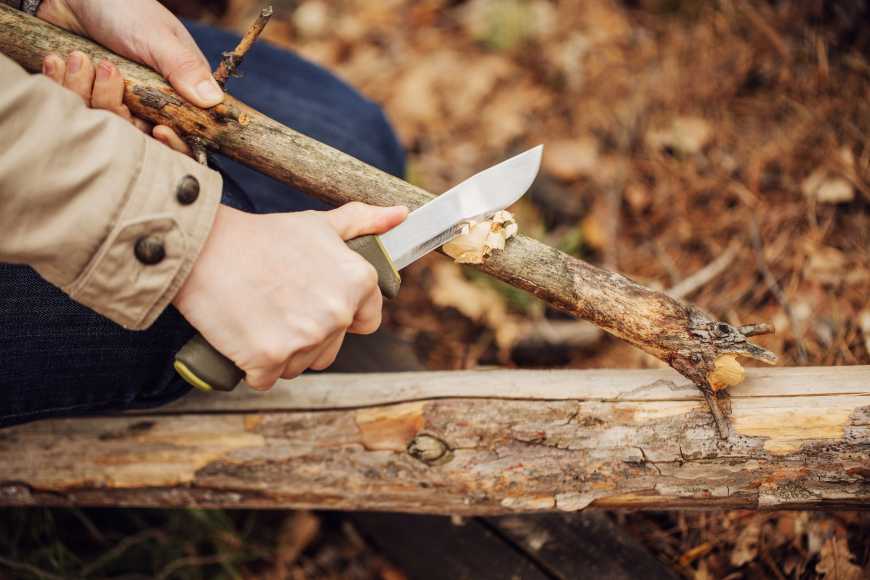0 Best Bushcraft Knife

When you're hiking or camping, you sometimes need to pull out a knife to trim branches, cut ropes, or even skin game.
That’s when having the best all around knife will serve you well. A Bushcraft knife, also referred to as a survival knife, is a great addition to your backpack.
Bushcraft knives can be used for activities as varied as rope trimming when you’re making camp or cutting tree limbs and wood carving, like when you want to make a firestick for cooking supper or roasting marshmallows.
The best all-purpose knife can also be used for more hard-core tasks like skinning animals, digging holes, or cleaning fish. The best outdoor knife is durable and reliable, but flexible enough for multiple uses. That means you don’t have to carry a variety of knives or other tools.
How do you know which is the best Bushcraft knife for the money? We have several we like, but first let’s look at considerations in choosing your best camp knife.
Blade Type
First, a quality knife will either have a full tang blade or one that’s hidden. A full tang means that the blade runs the entire length and width of the knife, and is visible on the handle frame. A hidden tang runs the full length and width but narrows into the handle so that you can’t see the tang itself. A full tang knife is more reliable than a partial tang knife.
In the same regard, you also want to opt for a fixed-blade camping knife, which is more reliable than a folding knife. Full-tang and fixed-blade means your knife will be able to handle extreme uses and perform under pressure better than the alternatives, a folding knife or one that has a partial tang.
Then there’s the blade material itself. The best steel for a survival knife is either carbon steel or stainless steel. Carbon steel survival knives are easy to polish and sharpen but can be subject to corrosion. Types of carbon that are good for a Bushcraft knife are A2 or VG-10.
Stainless steel survival knives are sometimes preferred for wet environments, because stainless steel won’t oxidize and corrode as easily as carbon. But they aren’t as strong as carbon. Types of stainless steel that are good for a survival knife include 440C or AUS8.
Finally, the edge of the knife can be serrated or non-serrated. The top bushcraft knives don’t have completely serrated edges, as it limits its uses and is difficult to sharpen. Instead, look for one that has a small portion of serrated edge and the remainder non-serrated, or a fully non-serrated edge. That increases its versatility. If you really need to saw, you might have to add a small saw to your pack.
Blade Design
Bushcraft knife designs tend to be one of three types:
- Clip point: Looks like the front third of the blade has been “clipped” on top, either in a straight or concave shape.
- Drop point: The blade slopes from the handle to the tip, with a convex curve.
- Spear point: As the name suggests, the blade tapers together at the end into a point or spear.
These three designs are intended to allow the tip of the blade to remain close to the center of the blade, and to the end of the hilt, giving you greater control over the knife than you would with a straight-back knife design.
Blade Size
The best bush knife has a cutting edge of about 4 inches long. If you’ve got large hands, you may want a blade that’s a bit longer, but it isn’t recommended to have a blade longer than 5 inches when choosing a survival knife. The ideal blade length for a Bushcraft knife – different than a large chopping tool, for instance – is anywhere from 3.5 inches to 5 inches.
Handle
A handle that’s strong and yet easy to hold with some kind of grip is ideal. It should also withstand temperature changes without breaking down or cracking.
One of the most popular handle materials for survival knives is Micarta, which is a fabric (usually canvas or linen) with resin added. The resin is heated to liquid form and then placed under pressure to make it solid.
Other choices in material include other fiber-reinforced plastic, textured rubber, stag bone and leather. Your choice may be dictated by your environment. For instance, you may want to avoid leather if you hike and camp in a damp environment.
Carrying the Knife
Your choice of the best wilderness knife may also be dictated by its carrying accessories, particularly If you have a certain way you like to carry your knife.
You might want one with a hole in the handle for a lanyard so you can wear it around your neck. You may want a sheath, and you may want a sheath made of a particular compound, like nylon or plastic. If you use the Molle accessory carrying system, it may be important to you to have a Molle-compatible sheath.
Perhaps you want a clip on the sheath for attaching to your belt or pocket. Some hikers even want a knife ankle holster for carrying on their leg.
Keeping these considerations in mind, let’s get to our bushcraft knife reviews.
 Carla Arbuckle
Carla Arbuckle






